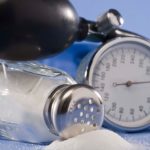 We’ve all heard it before – consuming too much salt in your diet can lead to high blood pressure, and high blood pressure can lead to an array of other health problems, such as stroke and heart disease. It is therefore important to minimize the amount of salt you eat daily. The recommended maximum salt intake level for a healthy adult is 1,500 mg per day, while the level for healthy children is 1,000-1,500 mg per day. 1,500 mg is equivalent to 2/3 of a teaspoon of table salt per day. Exceeding this level puts you at risk for health problems.
We’ve all heard it before – consuming too much salt in your diet can lead to high blood pressure, and high blood pressure can lead to an array of other health problems, such as stroke and heart disease. It is therefore important to minimize the amount of salt you eat daily. The recommended maximum salt intake level for a healthy adult is 1,500 mg per day, while the level for healthy children is 1,000-1,500 mg per day. 1,500 mg is equivalent to 2/3 of a teaspoon of table salt per day. Exceeding this level puts you at risk for health problems.
Many people think that salt only comes from a salt shaker, however, it is found in many foods that we regularly consume. Common culprits include: processed food, frozen dinners, and canned vegetables. However, there are many hidden sources of sodium, that you may be eating without even knowing that they contain high levels of sodium. These include:
– Condiments (ketchup, mustard, soy sauce, etc.)
– Salad dressings
– Cheese
– Canned tomato sauces
– Canned beans and vegetables
– Cereal
– BBQ sauces
– Baking soda and baking powder
– Breads such as hot dog buns, bagels, Kaiser buns, whole wheat pita bread
– Instant noodles
– Canned soups
– Canned and smoked fish
– Frozen waffles
– Clamato and V8 juices
It is also important to remember that kosher salt and sea salt are both still salt and must be limited.
While sodium lurks in many of the foods that we regularly eat, there are a number of things you can do to limit your salt intake, they include:
– Buy fresh fruits and vegetables
– Buy products that read “low sodium” or “no salt added”
– Be sure to read the nutrition label on products before purchasing to check the sodium content
– When dining out ask your server for a low sodium option
– Try seasoning foods with herbs and spices as opposed to salt
– Eat fresh meat, poultry and fish instead of canned or processed options
– Eat unsalted nuts as a snack instead of salty snacks like potato chips
– Limit processed meats such as cold cuts and hot dogs
The labels that explain the sodium content of a particular food can sometimes be confusing, to decipher the labels, take this into consideration.
- “Unsalted” – means that no salt has been added
- “Sodium-free”- means that one serving has a sodium content of 5mg or less
- “Very low sodium” – means that one serving has a sodium content of 35mg or less
- “Low Sodium” – means that one serving has a sodium content of 140mg or less
Additionally, if a product reads “less sodium” or “reduced sodium” it usually means that there is 25% less sodium than the regular version of that product. In general, these products still contain far too much sodium and should be avoided.
Reducing or limiting your salt intake will help to prevent many serious health conditions. While it may seem difficult in the beginning, the benefits are immense. If you continue to have difficulty, consult a dietician or a nutritionist to help you on your salt-limiting journey!
Advertisement
